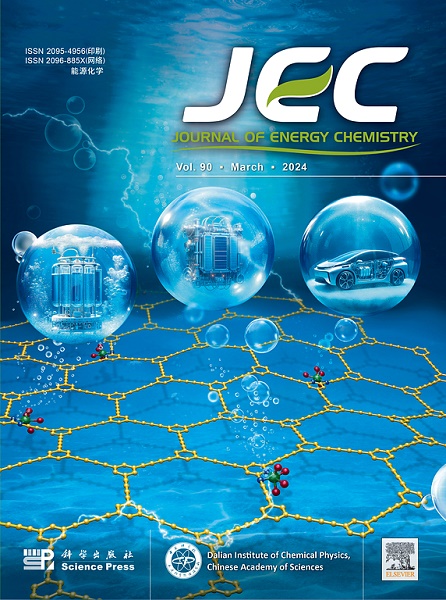Bifunctional macromolecular design for dual interface-passivating regulation towards practical stable lithium-sulfur batteries
IF 13.1
1区 化学
Q1 Energy
引用次数: 0
Abstract
Lithium-sulfur (Li-S) battery is recognized for the high theoretical energy density and cost-effective raw materials. However, the instability of Li metal anodes limits the cycle life of Li-S batteries under practical conditions. In this study, we propose a dual interface-passivating regulation strategy using nitrocellulose (NC), a macromolecular nitrate, to stabilize the interface/interphase between the electrolyte and Li metal anode. Specifically, the macromolecular crowding effect and the reduction in lithium polysulfides (LiPSs) activity through nitrate coordination endow NC desirable bifunctionality to simultaneously suppress the depletion of Li salts and LiPSs corrosion, leading to better interface passivation than mono-functional additives such as LiNO3 and carboxymethyl cellulose. Consequently, the cycle life of Li-S batteries under practically demanding conditions (50 μm Li anodes; 4.0 mg cm−2 S athodes) is extended to 180 cycles, outperforming those of additive-free or LiNO3-containing commercial electrolytes. This study highlights the potential of bifunctional macromolecular additive design for effectively dual-passivating the anode/electrolyte interface towards highly stable practical Li-S batteries.

实用稳定锂硫电池双界面钝化调控的双功能大分子设计
锂硫(li -硫)电池因其理论能量密度高、原材料成本低而被公认。然而,锂金属阳极的不稳定性限制了锂硫电池在实际条件下的循环寿命。在这项研究中,我们提出了一种双界面钝化调节策略,使用硝基纤维素(NC),一种大分子硝酸盐,来稳定电解质和锂金属阳极之间的界面/界面相。具体来说,大分子拥挤效应和通过硝酸盐配位降低锂多硫化物(LiPSs)活性赋予NC理想的双功能,同时抑制Li盐的耗尽和LiPSs的腐蚀,导致比LiNO3和羧甲基纤维素等单功能添加剂更好的界面钝化。因此,锂电池在实际苛刻的条件下(50 μm锂阳极;4.0 mg cm−2 S阳极)扩展到180循环,优于无添加剂或含lino3的商业电解质。这项研究强调了双功能大分子添加剂设计的潜力,可以有效地双钝化阳极/电解质界面,从而实现高度稳定的实用Li-S电池。
本文章由计算机程序翻译,如有差异,请以英文原文为准。
求助全文
约1分钟内获得全文
求助全文
来源期刊

Journal of Energy Chemistry
CHEMISTRY, APPLIED-CHEMISTRY, PHYSICAL
CiteScore
19.10
自引率
8.40%
发文量
3631
审稿时长
15 days
期刊介绍:
The Journal of Energy Chemistry, the official publication of Science Press and the Dalian Institute of Chemical Physics, Chinese Academy of Sciences, serves as a platform for reporting creative research and innovative applications in energy chemistry. It mainly reports on creative researches and innovative applications of chemical conversions of fossil energy, carbon dioxide, electrochemical energy and hydrogen energy, as well as the conversions of biomass and solar energy related with chemical issues to promote academic exchanges in the field of energy chemistry and to accelerate the exploration, research and development of energy science and technologies.
This journal focuses on original research papers covering various topics within energy chemistry worldwide, including:
Optimized utilization of fossil energy
Hydrogen energy
Conversion and storage of electrochemical energy
Capture, storage, and chemical conversion of carbon dioxide
Materials and nanotechnologies for energy conversion and storage
Chemistry in biomass conversion
Chemistry in the utilization of solar energy
 求助内容:
求助内容: 应助结果提醒方式:
应助结果提醒方式:


